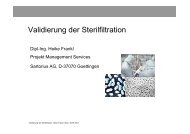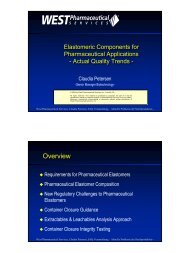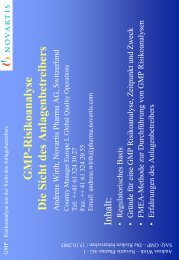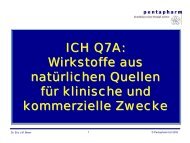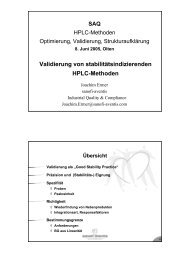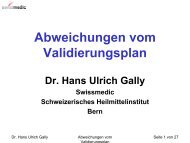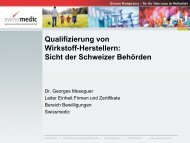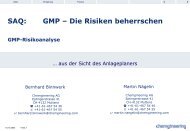Investigational
novartisnovartisnovartis
novartisnovartisnovartis
Create successful ePaper yourself
Turn your PDF publications into a flip-book with our unique Google optimized e-Paper software.
NOVARTIS<br />
Impurities –<br />
Issues in regard to quality and safety<br />
Lutz Müller<br />
Novartis Pharma AG<br />
Preclinical Safety EU<br />
<strong>Investigational</strong> and in silico Safety & Metabolism (ISIS)<br />
L. Müller, Swissmedic, 21-Oct-2003
Relevant guidelines<br />
NOVARTIS<br />
ICH Guidelines<br />
ICH Q3A(R) Impurities in New Drug Substances<br />
ICH Q3B(R) Impurities in New Drug Products<br />
ICH Q3C Residual Solvents (including maintencance)<br />
CPMP draft NfG (2002)<br />
Specification limits for residues of metal catalysts (on hold)<br />
CPMP draft position paper (2002)<br />
Limits for genotoxic impurities (on hold)<br />
L. Müller, Swissmedic, 21-Oct-2003
General approach for identification and<br />
qualification of impurities<br />
NOVARTIS<br />
Impurities are normally qualified in appropriate toxicological studies as part<br />
of a drug substance or drug product<br />
‣ It is assumed that their structure is normally close to that of the drug substance<br />
The toxicological qualification threshold for drug substance impurities is<br />
0.15% (0.5% for daily dose of more than 2g) = 1500ppm (or 500ppm)<br />
The (structure) identification threshold is 0.1% (or 1mg/day,<br />
whichever is lower)<br />
‣ (0.5% for daily dose of more than 2g) = 1000ppm (or 500ppm)<br />
Essential qualification studies are<br />
‣ Genotoxicity in vitro<br />
‣ A (sub) chronic toxicity study (in rodents)<br />
Specifications/levels in clinical batches should be covered by tox<br />
investigations<br />
‣ Either in acutal percentage<br />
or<br />
‣ with appropriate safety factors<br />
L. Müller, Swissmedic, 21-Oct-2003
What about highly toxic impurities?<br />
NOVARTIS<br />
“Identification of impurities present at an apparent level of not more<br />
than (≤) the identification threshold is generally not considered<br />
necessary. However, analytical procedures should be developed<br />
for those potential impurities that are expected to be unusually<br />
potent, producing toxic or pharmacological effects at a level not<br />
more than (≤) the identification threshold. All impurities should be<br />
qualified as described later in this guideline.”<br />
“For impurities known to be unusually potent or to produce toxic or<br />
unexpected pharmacological effects, the quantitation/detection limit<br />
of the analytical procedures should be commensurate with the<br />
level at which the impurities should be controlled.”<br />
‣ Issue: How to control, if you do not know the structure?<br />
L. Müller, Swissmedic, 21-Oct-2003
Potential presence of reactive impurities<br />
in drug substances<br />
NOVARTIS<br />
Process-related<br />
‣ Starting materials<br />
e.g. alkylating agents and similar reactive species<br />
‣ Intermediates / by-products<br />
e.g. strong acid/alcohol interactions<br />
‣ Catalysts, ligands<br />
Long-term storage<br />
‣ Degradation products (by oxidation?)<br />
Complete elimination of such impurities is often not feasible<br />
L. Müller, Swissmedic, 21-Oct-2003
Why to address the concern regarding high<br />
toxicity/non-reversible toxicity of impurities?<br />
NOVARTIS<br />
We do not want to put patients at undue risk of exposure to toxic agents if<br />
this is avoidable according to best technical procedures<br />
The presence of a genotoxic/carcinogenic impurity may falsely stigmatize an<br />
otherwise safe drug substance if there are no efficient means to eliminate<br />
influences of genotoxic impurities on the test results obtained with batches<br />
of “poor purity<br />
‣ e.g. testing of such batches would be a risk for two year carcinogenicity studies in<br />
rodents<br />
ICH guidances on impurities in new drug substances and new drug products<br />
state that: “analytical procedures should be developed for those potential<br />
impurities that are expected to be unusually potent, producing toxic or<br />
pharmacological effects at a level of not more than the identification<br />
threshold.”<br />
It is agreed that compounds of high acute or potentially non-reversible<br />
toxicity would fall into this category.<br />
‣ Genotoxic compounds are generally believed to have the potential to exert nonreversible<br />
changes in the genetic material<br />
L. Müller, Swissmedic, 21-Oct-2003
Genotoxic impurities – how to detect?<br />
NOVARTIS<br />
The structure of impurities present at levels above the identification threshold is<br />
known, their impact on safety of the drug substance can be appropriately assessed<br />
But: the ICH guidance on drug substance impurities does not stipulate identification<br />
of the structure of impurities below a level of 0.1% =1000 ppm (0.05% or 500 ppm if<br />
daily dose is above 2 g).<br />
1000 ppm (500 ppm) may be unacceptably high for an impurity if it is genotoxic.<br />
‣ A 2 g daily dose of a pharmaceutical may contain 2 mg of a potential toxin<br />
‣ E.g. 2 mg residues of an alkylating starting material would not be desired<br />
What would happen if you spike drug substance X with 1000ppm of an alkylating<br />
agent?<br />
Genotoxicity tests may not be sensitive enough to detect the effect of genotoxic<br />
impurities in a batch if the impurity is present at the 0.1% level<br />
In other words: few genotoxic compounds have a potency e.g. in the Ames that<br />
would enable their detection at or below 0.1% (the same is true for rodent<br />
carcinogenicity studies)<br />
‣ Without a structure, we do not have an idea whether we have a genotoxic impurity<br />
problem unless we start to approach the problem from the synthesis side<br />
L. Müller, Swissmedic, 21-Oct-2003
Genotoxic impurities - the limit of detection issue<br />
NOVARTIS<br />
Take EMS (ethylmethane sulfonate) and MMS (methylmethane<br />
sulfonate) as “model mutagenic impurities”<br />
‣ LOEC for EMS in Ames test is: 1500 µg/plate (TA 100)<br />
‣ LOEC for MMS in Ames test is: 15 µg/plate (TA 100)<br />
Question: at which level can you detect these as “mutagenic” in<br />
an Ames test of drug substance X<br />
Answer: assume that drug substance x is tested up to 5 mg/plate<br />
‣ EMS can be detected at 33.3% only (=330’000 ppm)<br />
‣ MMS can be detected at 0.33 % (15 µg in 5 mg =3’300 ppm)<br />
‣ A batch of drug substance X can be “qualified” as non genotoxic in an Ames<br />
test although it may contain e.g. 3’000 ppm MMS<br />
‣ Nevertheless, the presence of 3’000 ppm MMS is not acceptable<br />
Few genotoxic carcinogens have a detection limit in the Ames<br />
test below 5 µg/plate, which would correspond to 1000 ppm if<br />
expressed as “impurity” level in 5 mg drug substance<br />
L. Müller, Swissmedic, 21-Oct-2003
LOEL in genotoxicity assays by structural alert class<br />
Salmonella Reverse<br />
Mutation Assay<br />
Anthraquinones (12)<br />
N-Oxides (Aromatic) (5)<br />
Azirine/Aziridine (5)<br />
Aromatic Nitro (45)<br />
Aromatic Amines (48)<br />
Chromium (10)<br />
Vic Dihalides (6)<br />
Quinolines (18)<br />
PAHs (K-, Bay-Region) (7)<br />
Alkylating Agents (15)<br />
Nitrosamines/N-Nitroso (32)<br />
Isocyanate (4)<br />
Aliphatic Epoxides (21)<br />
Hydroxamates (13)<br />
Heterocyclic Nitro (3)<br />
Halogenated Methane (3)<br />
Hydrazo/Hydrazine (9)<br />
Rodent Micronucleus Assay<br />
0.0<br />
0.001<br />
0.01<br />
0.1<br />
Azirine/<br />
Aziridine (6)<br />
N-Nitroso (4)<br />
Alkylating<br />
Agent (15)<br />
Triazene (6)<br />
Aromatic<br />
Amine (9)<br />
Hydrazine (4)<br />
NOVARTIS<br />
mg/kg<br />
1<br />
100.0<br />
10.0<br />
0.0<br />
0.1<br />
1<br />
10.0<br />
100.0<br />
1000<br />
µg/ml<br />
0.0<br />
0.0001<br />
0.001<br />
0.01<br />
0.1<br />
1.0<br />
10.0<br />
Theoretical detection limit<br />
1 ppm<br />
% of drug substance if drug substance is 1mg/ml<br />
L. Müller, Swissmedic, 21-Oct-2003
CPMP draft position paper on genotoxic impurities<br />
(as of December 2002)<br />
NOVARTIS<br />
Issue of non-consistent regulatory action and deficits in the existing<br />
ICH guidances regarding genotoxic impurities was realized by the<br />
CPMP:<br />
‣ “In the case of impurities with a genotoxic potential, determination of<br />
acceptable dose levels is generally considered as a particularly critical<br />
issue, which is not specifically covered by the existing guidelines.” (from<br />
the introductory paragraph of the position paper)<br />
While regulatory action appears to be executed preferentially in late<br />
stages of the development process, it is better for us to implement a<br />
process of continuous data exchange between TRD and PCS to<br />
improve step-wise our syntheses with regard to a potential carry<br />
over of toxic impurities at “unacceptably” high levels into the DS<br />
‣ To avoid regulatory surprises<br />
‣ To minimise risks for volunteers and patients<br />
L. Müller, Swissmedic, 21-Oct-2003
Our Novartis policy regarding (geno)toxic impurities<br />
NOVARTIS<br />
We have introduced a new policy regarding the detection, testing,<br />
elimination and risk assessment of potentially (geno)toxic<br />
impurities in drug substances or drug products<br />
In general, the procedure starts with a “Computational toxicology<br />
assessment of every drug substance synthesis scheme”<br />
‣ Why?: focus on toxicological knowledge and informed decision making<br />
Product of this assessment and the interaction between<br />
chemistry and toxicology is a “Notification on the presence of<br />
unacceptable substances in synthesis” before Phase I trials.<br />
‣ This “Notification” is constantly updated throughout the development process<br />
‣ The “Notification” includes actions and measures regarding purity, limits<br />
based on toxicity and scientific rationales on these limits<br />
The new policy is described in a new world-wide SOP:<br />
“GENERATION OF THE SYNTHESIS SCHEME AND COMPLETION<br />
OF THE SYNTHESIS CONTROL FORM AND NOTIFICATION FORM<br />
FOR KNOWN AND POTENTIAL IMPURITIES”<br />
L. Müller, Swissmedic, 21-Oct-2003
What is the role of toxicology as described<br />
in this new SOP?<br />
NOVARTIS<br />
PCS assesses raw materials & intermediates for toxicity.<br />
If not listed in a general list of potential carcinogens, a structureactivity<br />
(in-silico) analysis for the presence of toxicological alerts is<br />
performed<br />
Are alerting structural elements present (primary focus on<br />
genotoxicity / carcinogenicity)?<br />
‣ Our present in silico systems give us about 80% accuracy for genotoxicity<br />
‣ The in silico systems are continuously improved with experimental data<br />
If no, then no special limits, normally no special testing needed.<br />
‣ Qualification according to existing ICH guidance procedures, i.e. appropriate<br />
(“dirty”) batches are tested<br />
If yes, a bacterial mutagenicity assay (Ames test) is normally<br />
initiated<br />
L. Müller, Swissmedic, 21-Oct-2003
Verification/falsification of structural alerts<br />
NOVARTIS<br />
Toxicology will perform Ames test (or other suitable test as indicated<br />
by structural alert)<br />
‣ Why primarily the Ames test?: it detects with greatest reliability DNA reactive<br />
compounds (or metabolites of them)<br />
‣ Most DNA reactive compounds are multi-organ carcinogens<br />
‣ Few false positives in the Ames test (Ames positive non-carcinogens)<br />
‣ Few toxins are known that are DNA reactive in mammalian cells but not in<br />
bacteria<br />
(<br />
Test(s) confirm in-silico hypothesis?<br />
If no, then no special limits, no special testing<br />
If yes, acceptable limits proposed adapted to the phase of the clinical<br />
program<br />
! Important: chemical expert reasonning can be an alternative to<br />
testing (and limit setting) especially in early phases of development !<br />
L. Müller, Swissmedic, 21-Oct-2003
The new SOP applied<br />
to Novartis projects in 2002<br />
NOVARTIS<br />
Evaluation period: 2002<br />
46 syntheses evaluated for the presence of alerting structures:<br />
in silico prediction plus published/in house data on genotoxicity or<br />
carcinogenicity<br />
‣ 6 syntheses were “clean”, i.e. no alerting structures were present<br />
‣ Recommendations for limitations or genotoxicity testing given for<br />
139 intermediates<br />
‣ 65 intermediates tested for genotoxicity (usually Ames screen in<br />
two strains, using less than 100mg substance)<br />
‣ 38 tested negative: no limits given<br />
‣ 27 tested positive: limits discussed<br />
‣ 20 syntheses out of 46 (43%) involve a mutagenic intermediate,<br />
which is potentially present as impurity<br />
L. Müller, Swissmedic, 21-Oct-2003
Setting limits based on toxicity data?<br />
NOVARTIS<br />
Toxic residual solvents/heavy metal catalysts limits are described in ICH<br />
or CPMP guidances (or draft guidance)<br />
However, there are extensive discussions in the quality and safety<br />
community on what are suitable/acceptable limits e.g. for genotoxins<br />
‣ Few compounds are sufficiently experimentally characterized (e.g. in rodent<br />
carcinogenicity studies) to do a reliable risk assessment<br />
‣ The draft position paper from the CPMP Safety Working Party is not very<br />
clear on this issue<br />
‣ Extensive comments via EFPIA and PhRMA have been submitted<br />
‣ It appears that the EFPIA proposal to adopt the concept of a “Threshold of<br />
Toxicological Concern (TTC) as applied in the food contact substances area<br />
may be acceptable to the CPMP<br />
‣ TTC lies at 1.5ug/day for lifetime exposure<br />
(exceptions: very potent carcinogens such as a few nitrosamines)<br />
‣ Proposed ICH topic?<br />
L. Müller, Swissmedic, 21-Oct-2003
Normally used formula for calculating<br />
permitted daily exposure (PDE) based on toxicology data<br />
NOVARTIS<br />
PDE (mg/day) =<br />
NOEL or LOEL (mg / kg) x human bodyweight (50 kg)<br />
F1 x F2 x F3 x F4 x F5<br />
Uncertainty factors F1 - F5 to account for:<br />
F1: Interspecies differences (surface area : body weight ratio for man<br />
compared to testing species; rat = 5, mouse = 12)<br />
F2: Inter-individual differences (10)<br />
F3: Duration of exposure (1-10)<br />
F4: Severity of toxicity (1-10) (is this sufficient for genotoxicity/carcinogenicity?)<br />
F5: Quality of data (1-10) / LOEL = 10<br />
L. Müller, Swissmedic, 21-Oct-2003
The dilemma of lacking data is<br />
a majorhindranceforusing<br />
NOEL‘s and uncertainty factors!<br />
NOVARTIS<br />
In vitro + in vivo genotoxicity assays are hazard identification<br />
tests, and thus do not provide data suitable for use in<br />
quantitative risk assessment<br />
Approach proposed (use of NOEL + UF) is unlikely to be<br />
feasible in most circumstances (no adequate data)!<br />
Pragmatic approach is needed (amount of impurity in µg/day<br />
considered as generally acceptable intake level)<br />
‣ The NOEL / UF approach can be used for toxicologically well<br />
characterized compounds, a condition, which is normally not<br />
met for impurities<br />
L. Müller, Swissmedic, 21-Oct-2003
Alternative to PDE calculation:<br />
the Threshold of Toxicological Concern (TTC)<br />
NOVARTIS<br />
This concept acknowledges a human exposure threshold value for chemicals<br />
(including those of unknown toxicity) below which there is no significant risk to<br />
human health.<br />
Established by the FDA (“Threshold of Regulation“) as a level “low enough to<br />
ensure that public health is protected, even in the event that a substance<br />
exempted from regulation .... is later found to be carcinogenic.“<br />
Examined for broader applications by ILSI Europe Task Group<br />
Based on an analysis of over 700 chemical carcinogens from the Gold et al.<br />
carcinogenic potency database<br />
‣ estimate of a human exposure threshold value for a high probability of not<br />
exceeding a 1x10 -6 cancer lifetime risk :<br />
‣ 1.5 µg/person/day (= no safety concern!)<br />
‣ both, genotoxic and non-genotoxic carcinogens are covered in the<br />
database!<br />
L. Müller, Swissmedic, 21-Oct-2003
Translate Threshold of Toxicological<br />
Concern (TTC) in ppm?<br />
NOVARTIS<br />
Maximum levels of impurity in a chronic use drug<br />
(scenario for “PDE’s” between 0.05 and 50 ug/day)<br />
PDE* for<br />
impurity<br />
(µg/day)<br />
Max. content (in ppm) of impurity in drug substance if<br />
daily dose of drug (g/day) is:<br />
0.1<br />
1<br />
2<br />
5<br />
0.05<br />
0.5<br />
0.05 0.025 0.01<br />
0.5<br />
5<br />
0.5<br />
0.25<br />
0.1<br />
1.5<br />
15<br />
1.5<br />
0.75<br />
0.3<br />
5<br />
50<br />
5<br />
2.5<br />
1<br />
50<br />
500<br />
50<br />
25<br />
10<br />
* Denotes “Permitted Daily Exposure<br />
To be used if Threshold of Toxicological Concern will be generally accepted<br />
L. Müller, Swissmedic, 21-Oct-2003
Deviations from TTC possible (if justified)<br />
NOVARTIS<br />
route of administration<br />
target population / proposed indication<br />
toxicology of the impurity in relation to the active substance<br />
high potency carcinogens excluded from TTC<br />
(“the dirty four“)<br />
‣ aflatoxin-like compounds<br />
‣ azoxy compounds<br />
‣ N-nitrosamines<br />
‣ tetrasubstituted dibenzodioxins and dibenzofurans<br />
L. Müller, Swissmedic, 21-Oct-2003
Advantages of Using the TTC Concept<br />
NOVARTIS<br />
scientifically (databases) derived threshold<br />
(in contrast to the arbitrary use of uncertainty factors)<br />
conservative approach resulting in low ppm values<br />
can be applied even without preclinical data!<br />
will provide more consistency in controlling genotoxic<br />
impurities than case-by-case use of NOEL+UF-derived limits<br />
already accepted for regulatory purposes<br />
L. Müller, Swissmedic, 21-Oct-2003
Regulatory Applications of the TTC Concept<br />
NOVARTIS<br />
FDA (“Threshold of Regulation“): for indirect food additives =<br />
food contact material<br />
Joint FAO/WHO Expert Committee on Food Additives<br />
(JECFA): for flavouring substances<br />
Could this concept be applied more widely than just to food<br />
toxicology?<br />
L. Müller, Swissmedic, 21-Oct-2003
Are there alternative concepts for acceptable limits?<br />
NOVARTIS<br />
Acceptable level of intake of genotoxic impurities should be<br />
set in relation to daily intake of food mutagens (1g/day)<br />
‣ “no risk“ level for a genotoxin: 10 - 100 µg/day<br />
(“safety margin“ of 4 -5 orders of magnitude below the “daily<br />
mutagenic burden“!)<br />
Fiori & Meyerhoff (Eli Lilly): “Extending the Threshold of<br />
Regulation Concept: De Minimis Limits for Carcinogens and<br />
Mutagens“<br />
(Regul. Toxicol. Pharmacol. 35, 2002, 209-216)<br />
‣ “no risk“ level for a genotoxin: 90 ng/day<br />
‣ “no risk“ level for a carcinogen: 9 ng/day<br />
These are no real alternatives!<br />
L. Müller, Swissmedic, 21-Oct-2003
Case study I<br />
4-hydrazinobenzoic acid in a life saving oncology product<br />
NOVARTIS<br />
Synthesis involves 4-hydrazinobenozoic acid (4-HBA)<br />
‣ Hydrazine is IARC Group 2B, 1,2-dimethylhydrazine is in Group 2A<br />
‣ 4-HBA is a weak Salmonella mutagen<br />
‣ 4-HBA does not induce chromosome aberrations in vitro<br />
‣ Limited published data indicate tumorigenic effects in rats (one dose level only tested<br />
in drinking water, low survival)<br />
but: Agaricus bisporus, the major cultivated mushroom of the Western<br />
Hemisphere (=champignon), contains 4-HBA at a level of 10 µg/g<br />
(10ppm) wet mushroom weight<br />
‣ One champignon meal (200 g) contains 2000 µg 4-HBA<br />
‣ Does exposure to 4-HBA really constitute a genotoxic/tumorigenic risk?<br />
‣ Which level would be acceptable in a pharmaceutical (life saving) preparation with<br />
life-long high daily dose<br />
• Would 5 or 10 ppm be too much, can we compare the risk in XYZ123 with eating<br />
champignons?<br />
5ppm 4-HBA in XYZ123 (the current limit) translates into an exposure of<br />
10µg/day<br />
‣ This level is considered appropriate based on the life-threatening indication and the<br />
relatively weak genotoxic/carcinogenic potential of this hydrazine<br />
L. Müller, Swissmedic, 21-Oct-2003
Case study II<br />
epoxide degradation product in mometasone (published case)<br />
NOVARTIS<br />
Mometasone (corticosteroid):<br />
‣ Daily dose ~1600 µg<br />
Epoxide degradation product in<br />
aequeous systems<br />
The epoxide is a toxicological<br />
concern<br />
Limit setting approach according to<br />
TTC:<br />
‣ 1.5 µg < 1000 ppm!<br />
Alternative: toxicological testing<br />
‣ Limited to 1000ppm<br />
‣ Below threshold of toxicological<br />
concern (not published with that<br />
reasoning)<br />
‣ Apparently no specific toxicity<br />
studies<br />
‣ Proactive limitation in the absence of<br />
detailed tox data?<br />
L. Müller, Swissmedic, 21-Oct-2003
Case study III: Imatinib (Gleevec)<br />
Maximum daily dose of Imatinib is 800 mg<br />
STID6 bears structural alerts, and is positive in several<br />
genotoxicity systems as well as yielded toxicological findings<br />
(hyperplasia, necrosis) in various organs in a 4-week study in<br />
rats<br />
Drug substance batches spiked with up to 280 ppm yielded<br />
negative genotoxicity test results (could have been predicted by<br />
calculation)<br />
Limit based on technical feasibility is 20 ppm<br />
‣ Highest human daily uptake/exposure would be 8 and 16 µg<br />
(equivalent to 1.6 and 3.2 ng/ml blood assuming total absorption)<br />
‣ Human exposure is clearly below in vitro genotoxic concentrations<br />
‣ But: D6 (CGP53715) is formed as major metabolite in mice and<br />
rabbits<br />
‣ No major pathway in rats, dogs, humans<br />
‣ But: are analytical methods capable of excluding D6 as a minor<br />
human metabolite<br />
‣ It does not make sense to be very strict with applying low ppm<br />
limits for impurities, but to be not able to exclude formation by<br />
metabolism at higher levels<br />
‣ Problem not considered important for the current life saving<br />
indications of Gleevec<br />
Gleevec<br />
N<br />
D6 (507-00)<br />
N<br />
NOVARTIS<br />
N N H NH<br />
N<br />
L. Müller, Swissmedic, 21-Oct-2003<br />
N<br />
N<br />
N<br />
O<br />
N N H NH 2
Decision tree for assessment of<br />
acceptability of genotoxic impurities<br />
(according to publication draft by Peter Kasper, the relevant<br />
drafting “regulator“ on the CPMP side)<br />
NOVARTIS<br />
Established carcinogenicity<br />
from long-term studies?<br />
NO<br />
YES<br />
Genotoxicant with<br />
unknown carcinogenicity<br />
Genotoxic<br />
carcinogen<br />
Threshold-related<br />
mechanism?<br />
Eliminate?<br />
YES<br />
NO<br />
NO<br />
Determine<br />
Permitted<br />
Daily Exposure<br />
(NOEL + UF)<br />
Control below<br />
“Threshold of<br />
Toxicological<br />
Concern“<br />
Quantitative<br />
risk assessment:<br />
Determine<br />
acceptable dose<br />
L. Müller, Swissmedic, 21-Oct-2003
Proposal by Novartis/EFPIA<br />
group for a flow chart on<br />
genotoxic impurities<br />
NOVARTIS<br />
L. Müller, Swissmedic, 21-Oct-2003
Next Activities on genotoxic impurities<br />
NOVARTIS<br />
Scientific fora (experts from Industry, SWP & QWP)<br />
‣ DIA case study workshop in London on October 28-29)<br />
‣ EFPIA/CPMP round table to discuss & judge the implications of<br />
the various suggestions (also from a pharmaceutical point of<br />
view)<br />
Finalization of the EU Position Paper in 2004?<br />
Need of international harmonization within the ICH<br />
framework?<br />
L. Müller, Swissmedic, 21-Oct-2003
Some conclusions, but not necessarily all inclusive<br />
NOVARTIS<br />
A genotoxic (mutagenic) impurity is potentially present in ~40% of all<br />
drug substances although batch testing for genotoxicity yielded<br />
mostly negative results<br />
For most of the genotoxic structures that show up in drug substance<br />
syntheses, there is no preexisting knowledge from published<br />
literature (i.e. we would have to generate the data)<br />
Organic chemistry involves the use of reactive materials, which may<br />
be genotoxic. Of course, it would be naïve to assume that this could<br />
be totally avoidable<br />
L. Müller, Swissmedic, 21-Oct-2003



